Thinking Outside the Stage|Part 4: About the Project|Ayaka Ono Akira Nakazawa Nakazawa Yo Space Not Blank × Dance Base Yokohama
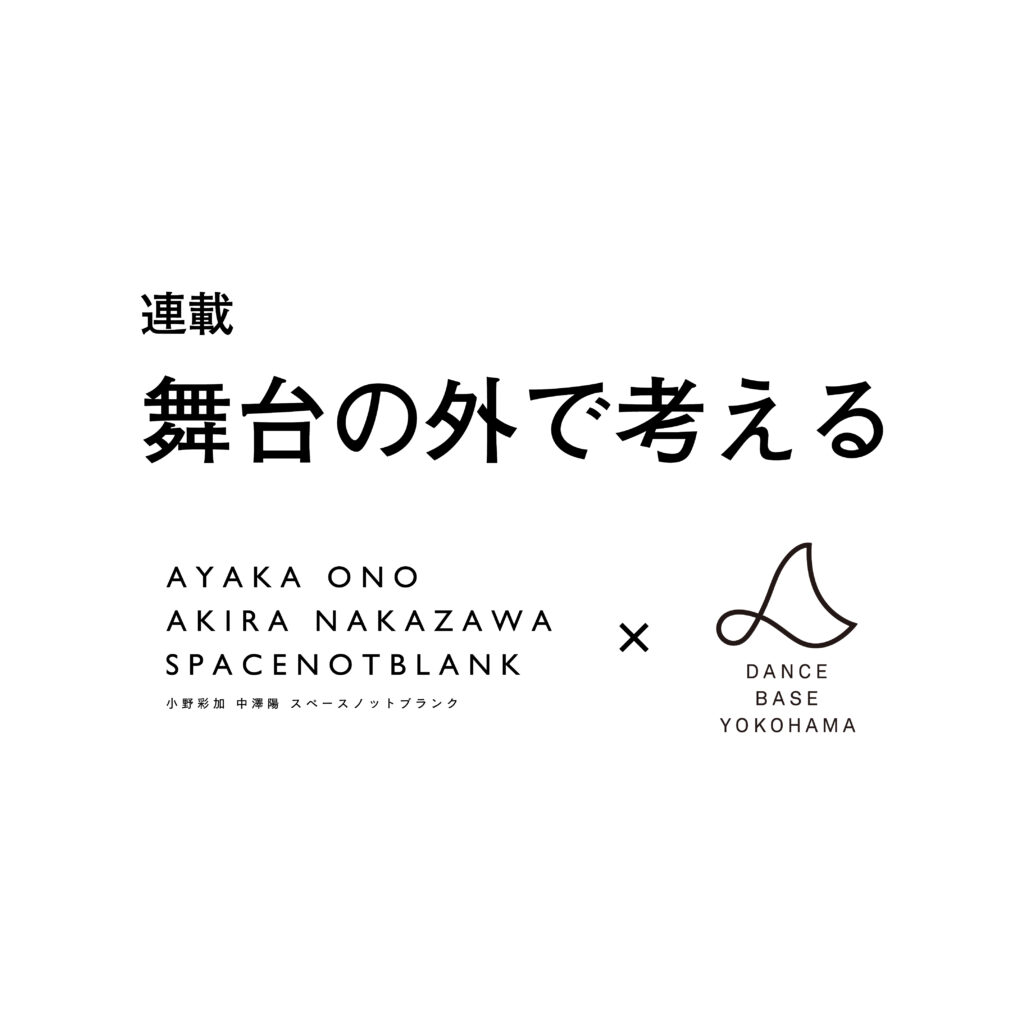
Thinking Outside the Stage” is a series of articles by Ayaka Ono Akira Nakazawa Nakazawa Spacenotblank, in which she presents her thoughts from perspectives beyond the framework of performance. The series is a joint project between Ayaka Ono Akira Nakazawa Spacenotblank and Dance Base Yokohama, and each installment alternates between the two websites. The experimental and introspective series explores various aspects of the performing arts and highlights new relationships between artists and the creative environment.
▶︎Part 1 “About the Assistant Director”|Ayaka Ono Akira Nakazawa NakazawaSpacenotblank
▶︎Part 2 “About the Residency Program “
▶︎Part 3 “About Loss”|Ayaka Ono Akira Nakazawa Nakazawa Yoko Spacenotblank
synchronicity
Think about the “plan. The greatest emphasis is placed on its “look,” i.e., the “look” of the project. Input is not seen as an act of “increasing” the number of choices in proportion to increasing the amount of information in the body, but rather as an act of “reducing” it. A subtraction that does for refinement. Good influences, good stimuli are simply accepted as “good”, we become aware of them as “others” to the world, we explore what only we can “make” them experience, and we continue to refine and refine the “expression” of the output.
The world of performing arts is small. Not only in the performing arts, but in other parts of the world, “similar” things can appear simultaneously and frequently in various places without knowing each other. We find this “contemporaneousness” interesting. What we must fear, however, is a “lack of objectivity” due to a “lack of originality. We must always be keenly aware, consciously or unconsciously, of objective “déjà vu” when we think of a “project.
Our “expressions” were also described as “something-like” in the past. It has really gone away recently. Maybe it’s just that people don’t say it anymore, even if they think it is. In any case, it would be extremely healthy and happy if people kept saying “I don’t know” more and more. Even if what we are told is “something-like” is in fact a comparison with something we have never experienced, or in other words, a manifestation of a “contemporary” resonance, we thoroughly research and input the subject of that “something-like. And we have continued to make the decision not to “do” everything that seems “like” it. It is not a sensible thing to call it a survival strategy, but simply because we don’t feel good about it. So we surely are not developing our mechanisms “towards interesting”. We would be grateful if the result would be more interesting, but we are sure that it is because “it would be more interesting if we did it this way” is a choice that we can easily make. We seek to discover routes that “others” would not choose and share with the world. It is only because “what someone else will do for us is not what we should do”.
We were asked to direct a reading performance of René Poreche’s “I Want to Look Deep Into Your Eyes, A Blind Relationship Common in Human Society” at Theatre Commons ’25. I am ashamed to admit that I knew nothing about René Poreche. From there, I read the interview and the play, and learned that the “way” of Rene Poreš’s text is very similar to our own text generation mechanism, “listening. The only slight difference is that our mechanism was developed from the point of view of the “other,” while René Pollesch, I am not sure if this is correct, explores from the point of view of the “self” in relation to society and the world. We have spontaneously arrived at a method similar to that of René Pollesch from a place where we did not know René Pollesch. It was synchronicity. I was surprised and grinned, but at the same time, I still think that we must “complete” the “listening” process as soon as possible.
I want to see through the depths of your eyes, the blind relationships that are common in human society|Theatre Commons ’25 February – March 2025 Goethe-Institut Tokyo
©︎ Theatre Commons ’25 / Photo by Ryohei Sawaki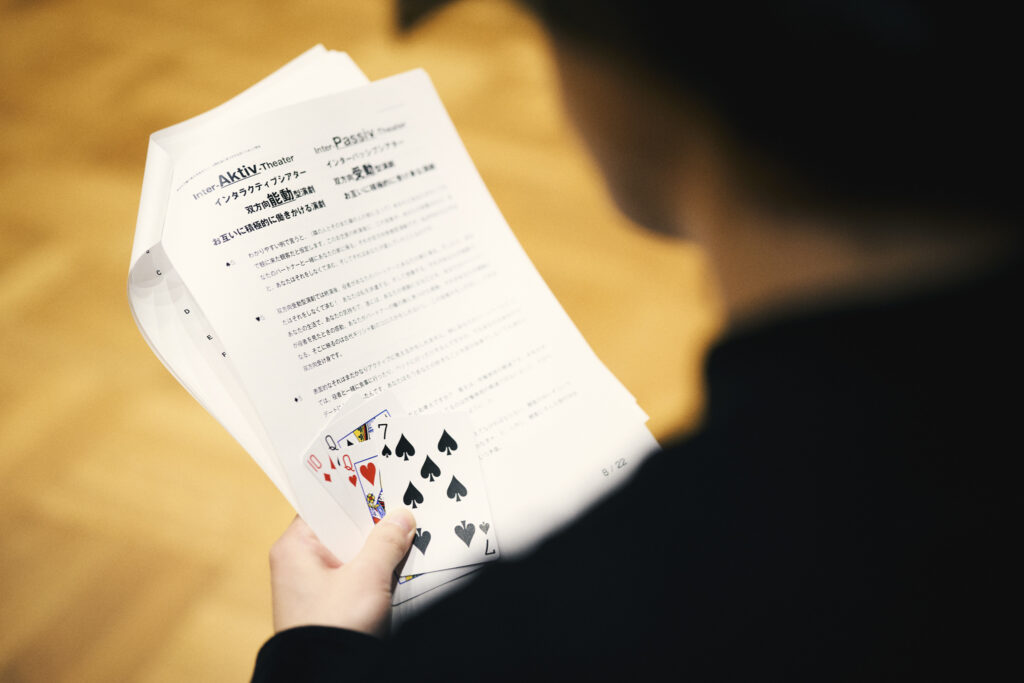
Leading Performance
As a sense, our creative work involves imagining, researching, practicing, and assembling a hand of things with a capacity ten times greater than the things that will be represented in the final “performance. We decide which of the cards in our hand we think are the right ones to actually be shown in the “performance” and assemble them according to our leadership. What we do as directors is to “create” and to “experience” what has been “created. If we are obsessed only with “creation,” we will be devoted only to the expression of ideas, and we will leave it to the audience to decide whether or not the quality of the “expression” of the “performance” can be guaranteed. On the other hand, if we are fixated only on “experiencing,” the position of “staging” becomes unnecessary in the true sense of the word. Therefore, we would like to repeat the process of “creating” and “experiencing” alternately, and do our best to carefully judge what is appropriate for each “performance” to “express” to the audience. Frankly speaking, we can say that we are doing what we want to do and performing what we want to experience. If not, I don’t think it is worth paying money to visit the theater. We love the curiosity of our audiences and believe in their imagination.
René Poreš, “I want to see through the depths of your eyes, the blind relationships that are common in human society” We were asked to direct a reading performance, and here is what we considered in light of our “project”. First, instead of giving an overview of the reading performance, I will quote from the text we contributed to the pamphlet on the day of the performance.
I am concerned that some people may think that a “reading performance” is a performance in which everyone “watches” a performance of a reading of a play. However, this is a performance in which everyone “performs” a reading of a play. We have participated in Theatre Commons as volunteers since the third Theatre Commons ’19, and we have performed “Alice in Bed” by Susan Sontag, directed by Yuko Nakamura, and “Sarashiki” by Shogo Ota, directed by Yuta Hagiwara. After showing the audience around, we performed in Shogo Ota’s “Clearing Land” directed by Yuta Hagiwara. The following year, due to the Corona Disaster of 2020, Theatre Commons ’20’s reading performances (Giacomo Puccini’s “Madame Butterfly,” directed by Satoko Ichihara, and Shuntaro Matsubara’s “Mind the Front,” directed by Daichi Nakamura) were changed to online delivery, They will not be performed after Theater Commons ’21, and will finally return this year.
Having volunteered for Theater Commons ’19, we had a prior understanding of the reading performance form. Because of its high resolution and our coincidental affinity with René Poreš, we felt strongly that the request for this production was inevitable and that we would be able to express what only we could.
We began considering how not to make it an ordinary round reading, but we imagined that it would never be ordinary when the premise of the project was that Sachiko Hara would be present at the performance as dramaturg, translator, adaptor, and performer. The relationship between the audience ≒ us ↔︎ and Sachiko Hara ↔︎ and René Poreš was established beforehand, and we, as the “first audience,” learned about and received René Poreš’s plays, words, artistic ideas, and way of life through Sachiko Hara, even though we were the director. As “directors,” our focus was to consider how to incorporate what we had received into the reading performance format, and to give it form. In other words, we had to give “our own rules” to this unique form of performance.
The total number of audience members is basically assumed to be 25, and a setting in which each person will read the dialogue approximately two times each was considered appropriate. We divided the dialogue into 50 or so sections and assigned a number to each. The idea of distributing numbered playing cards to define the reading points was proposed, but just before the time came to make the numbered cards, we realized that there were 52 playing cards, excluding jokers, and switched to using playing cards instead of numbered cards. The seating arrangement was set up to “look” like a “gathering place,” with chairs arranged so that they were seated in a circle. By randomly distributing playing cards, the order of reading was not in the order of the seats, and the lines to be spoken were appropriately distributed according to the cards they held, creating a time and space that resembled a “reading session” in a play. This was also the spatial setting that Sachiko Hara had told me about during rehearsals, and which reminded me of the creative environment of René Poreche. The fact that we were able to successfully complete all the performances during the short, intensive performance schedule was due to the great efforts of Yumi Okada and Masao Sekiguchi, who interned at Theater Commons, Satoshi Ozaki, technical director, Ken Inarimori, sound planner, Haruka Fujisaki, production manager, and all the other staff members at Theater Commons. I would like to take this opportunity to express my sincere appreciation for their efforts.
Our staging is not a process of pulling something out of some unknown place just for the sake of our presence and trying to create a new measure by passing it through a filter, but rather a process of considering how the impressions we receive of the play can be shared with the audience by allowing them to penetrate us I believe that it is not a work of trying to create a new scale by passing through a filter. We want to be colorless and transparent in our thoughts, our purpose, our ego, and other aspects of our performance. It is our character, our color, our authorship, and the parts of us that are inexplicable to even us that can drift in that transparency. It is because this attitude is “interesting” that we are currently choosing the performing arts, and we ourselves are most curious about what awaits us “next” in this exploration.
I want to see through the depths of your eyes, the blind relationships that are common in human society|Theatre Commons ’25 February – March 2025 Goethe-Institut Tokyo
©︎ Theatre Commons ’25 / Photo by Ryohei Sawaki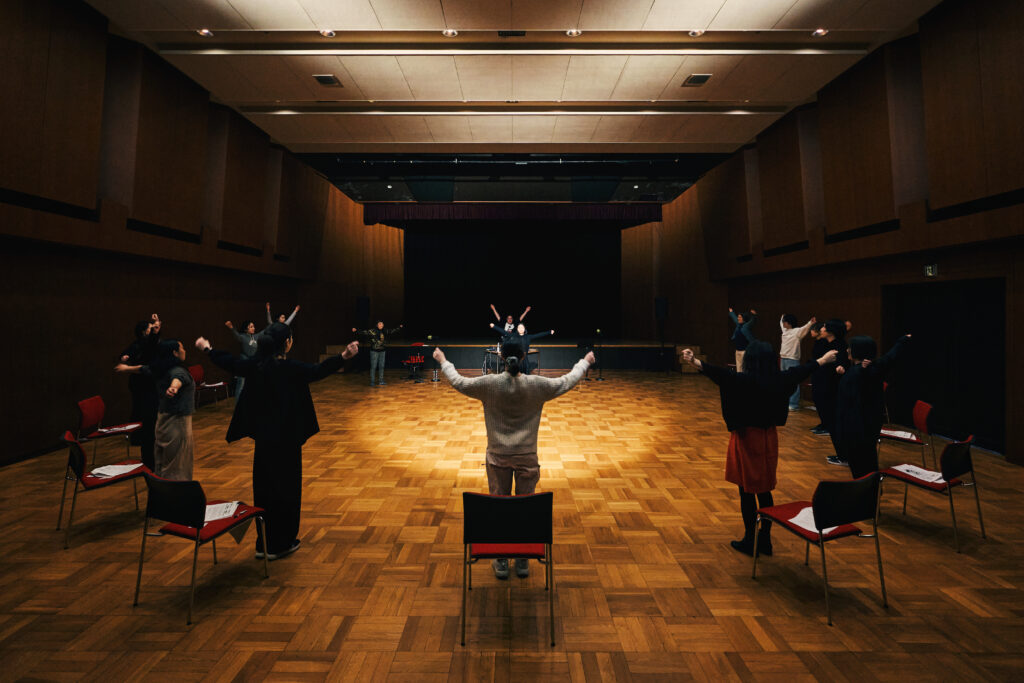
reaction
Planning” is born from “reaction. If you have been creating dance for a long time, you will gradually want to create theater, and if you have been creating theater for a long time, you will gradually want to create dance. It is also a fact that, after a long period of creating on the stage, one wants to retire from the stage and create music, movies, paintings, and sculptures.
We have used the unique mechanisms of “listening” and “physical catharsis” to demonstrate our “originality,” while at the same time concurrently “planning” to use different guidelines and team compositions born of these repercussions. The following is a rough breakdown of what we have done.
An original work using the unique text generation mechanism “Kikitori”
The 8th Sengawa Theatre Theatre Competition, Grand Prix winner, the first work using “Kikitori”, ” Love Dialogue Now “. Hajitotachi “, aiming at the stirring of realism. Ice and Winter ” and ” Theatre of the Savior ” are cold stage productions. The Object Trilogy, ” Stage-like Monuments,” ” Words and Shakespeare’s Birds,” and “Atoms.
An original work using the unique choreographic mechanism “Physical Catharsis”
Yokohama Dance Collection 2022 Competition I, Kinosaki International Art Center Prize and the French Embassy in Japan Dance Reflections for Young Choreographers by Van Cleef & Arpels Award. The last phase of “Physical Catharsis” = “Balance”. Dance Work No. 1: Claude Debussy’s “Practice “, Dance Work No. 3, etc., in which “physical catharsis” = “dance before dance work” becomes “dance work”.
Collaboration with playwright Shuntaro Matsubara.
” Sasayakaisa ” premiered in 2019, rewritten and performed again in 2021; ” Alice in the Light ” premiered in 2020, recast and performed again in 2024; ” Miraiha ” premiered in 2021, produced as “Theater Created with High School Students” at the HONOKUNI Yohashi Arts Theater PLAT. Theater and film fusion ” Regeneration Number, ” premiered at KYOTO EXPERIMENT 2022; ” Dance Dance Revolutions,” premiered in 2023 and performed again in 2024, produced by writing the play and building the performance at the same time, with Shuntaro Matsubara also appearing in the production.
Meghagi Saga (in collaboration with Ryo Ikeda, playwright, director, screenwriter, and plastic artist, and Taishi Nukata, composer and director)
Part 1: ” Wear. Part 2 ” Hawaawa “. Spin-off ” Sei “. Part 3: “Norn”.
Inherited Bodies” series derived from “Physical Catharsis”
contact Gonzo Physics Series ” Choreographic Concepts for the Untrained Layman. Shu Matsui and Us,” based on Jerome Bell’s ” Pitche Kranchen and Me. Junnosuke Tada, ” Rebirth.
Our activities are diverging due to “reaction”. And they are also converging. Objectively and subjectively, we appear and feel to be neither. But it also looks and feels like everything is connected. They are “both”. And the current place of our “project”, which has been “recoiled” over and over, is in the phase of “verifying” the “work” as a “work”.
I want to see through the depths of your eyes, the blind relationships that are common in human society|Theatre Commons ’25 February – March 2025 Goethe-Institut Tokyo
©︎ Theatre Commons ’25 / Photo by Ryohei Sawaki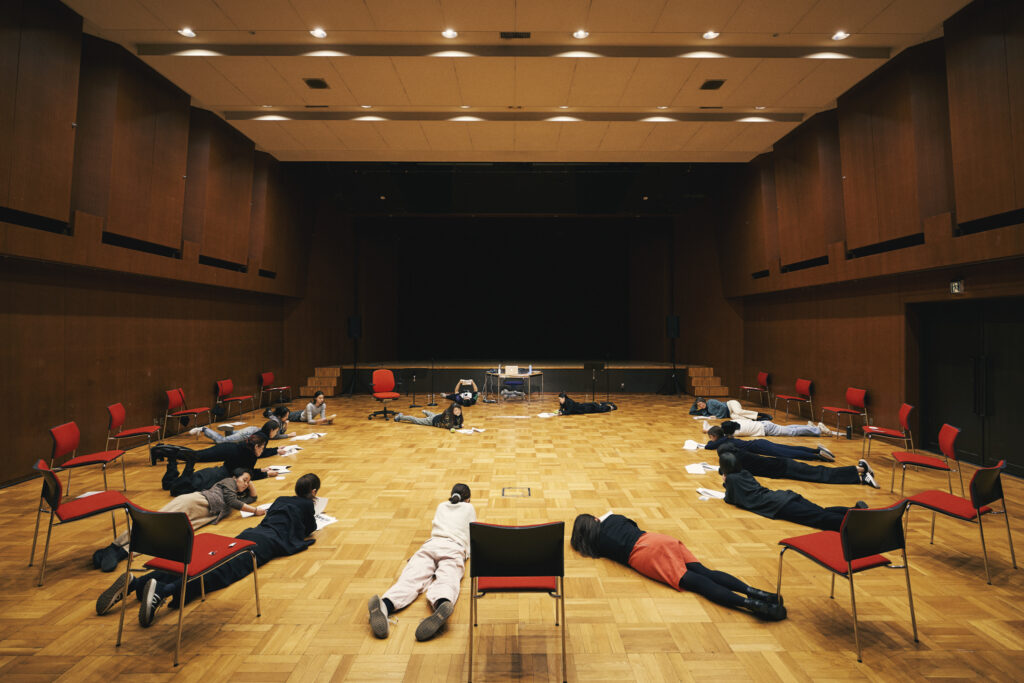
Alice in the Light” and “Dance Works
I want to create a new team. I thought so after finishing the performance of “Dance Work No. 1: Claude Debussy’s “Practice” (hereinafter referred to as “Dance Work No. 1″), Part 1” in January 2025. We are lacking in examples of “examining” a “work” as a “work of art” because we have not had the opportunity to do so.
In the performing arts, I feel that many of the reasons for creating repertory works from the beginning and continuing to perform them in the same form, even changing the performers if the schedule does not allow for repeat performances, are “business reasons. Due to the media characteristics of the performing arts, we who are alive age along with the audience, and our way of thinking changes with each era. Following the repercussions is the main reason for us to explore the performing arts, and the “next” principle will be waiting for us as soon as possible.
It is true that I still think so. However, perhaps as a reaction to this, I have become interested in how the performing arts medium “remains” after 2021. For example, the “Object Trilogy,” which is being produced with the use of “listening comprehension,” is a work that reverses the stance that the text produced through “listening comprehension” is only a “byproduct of the performance,” and that the final destination is to produce and preserve a “play. Furthermore, the “Inheriting Bodies” project was an attempt to experience the “mechanisms” developed by the previous generation of artists with the same desire to express their originality, and to revive them in the present age, just as we create our own original mechanisms of “physical catharsis”.
The premise is that following “business expediency” is important because it is universal, and we do not view it negatively at all. We just wanted a basis for our own inquiry into the media characteristics of the performing arts. And now, although we do not yet know how many people have come to examine it fundamentally, we believe that in the performing arts, there is a new “work” value that can be verified by “inheriting” it.
Alice in the Light” is the second production in collaboration with playwright Shuntaro Matsubara, which premiered at the North Hall of the Rohm Theater Kyoto in December 2020, and will be performed again at the Theater Tram in November 2024 with new cast members Saho Ito and Masahiro Higashide. Saho Ito’s Minnie was played by Mina Sasaki in the first performance, and Masayuki Yano played Masahiro Higashide’s Bunny in the first performance. For us, this was the first time to “perform the same work with different performers. Until then, if the performers were changed, the work would usually be completely different, even if the title was the same. In the preliminary discussions with Shuntaro Matsubara, we decided not to “rewrite” the piece, but to present it as a pure update of the first performance, with the exception of some new staging to accommodate changes in the cast and the venue.
As a result, “change” in the performing arts, as compared to “change of the times,” is something that occurs naturally and without any effort on our part to change, we are forced to change. Perhaps we have been afraid of not changing. It was an experience that made me realize that sometimes being too critical of the characteristics of the media can deprive us of the opportunity to “examine” them for ourselves.
And it is a “dance work”. The biggest difference in our concept of making a “dance” into a “dance work” is that we allow the choreography to be “delegated”. If the dancers change, the “expression” may also change. However, in the “dance works” that we have created, are creating, or will create, the “choreography” will be preserved as basically unchanged, and the dancers will be given the opportunity to “examine” the “work” as a “work” each time it is changed. The choreography created through “physical catharsis” has its own original identity. However, the “delegation” of choreography is not an act of denying the original. It is possible to “express” the new identity of the new dancer as a new interpretation of the original. This is what we have learned from the experience of reenacting “Alice in the Light. We first accept the value of a “work” as a large framework. Even if a different body of work or a different interpretation appears, the value of the work itself does not change significantly. Rather, the more repeated the verification, the more repeated the delegation, the more multilayered the value of the “work” becomes. Even if a “look” that is completely different from the original eventually appears, I am convinced that this can be “expressed” as the greatest universality in the medium of performing arts.
I want to see through the depths of your eyes, the blind relationships that are common in human society|Theatre Commons ’25 February – March 2025 Goethe-Institut Tokyo
©︎ Theatre Commons ’25 / Photo by Ryohei Sawaki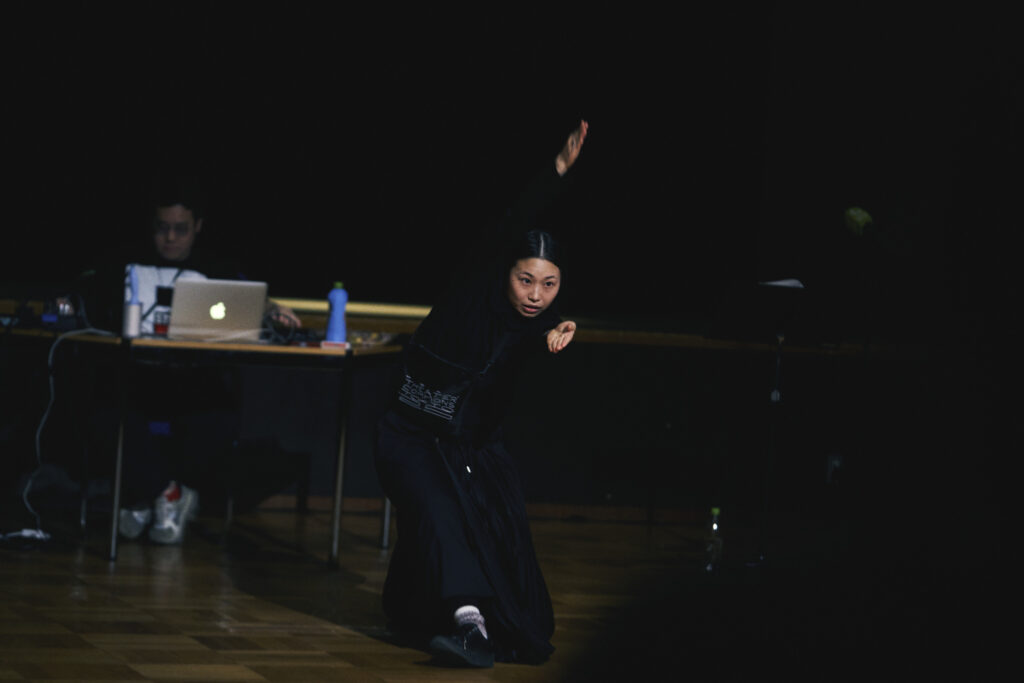
Knots
We want to create a new team. For the second part of “Dance Work No. 1,” we would like to start by “delegating” the choreography created in the first part to a new dancer. Currently, we are considering how to meet these “new dancers” and how to plan for them. There is a strong possibility that we will have an open call (open call). We would like to meet dancers who are interested in our methodology and are willing to be “delegated” on the premise that they bring their own body and expression to “trace” rather than just “copy”. We would like to create a new team, so as to build a bond with those who agree with our new methodology and are willing to collaborate with us in assembling a series of repertory “works”.
We imagine that “Dance Work No. 3” will be a “dance work” that surfaces narrative as story or situation rather than narrative as narrative, compared to “Dance Work No. 1”. While we are aiming for a preliminary completion, we continue to explore the possibility of “delegation” beyond that point. We want to continue to have our “works” as new cards in our hand, and to foster a state in which our “works” can be performed in any place and interpreted in any way. We welcome actors, dancers, performers, and others whom we do not know to perform our “plays” and our “choreographies” in their own interpretations.
Dance No. 4 will be an intermittent production by a new team. Dance Work No. 5 will be a short, spectacular, portable work that can be performed many times. Dance Work No. 6 will be an exploration of a phase of “physical catharsis. Dance Work No. 7”, “Dance Work No. 8”, and so on, our exploration of “project” by “reaction” knows no bounds. How far do we intend to go? We ourselves are most anxious to find out what is waiting for us “next” in this exploration.
I want to see through the depths of your eyes, the blind relationships that are common in human society|Theatre Commons ’25 February – March 2025 Goethe-Institut Tokyo
©︎ Theatre Commons ’25 / Photo by Ryohei Sawaki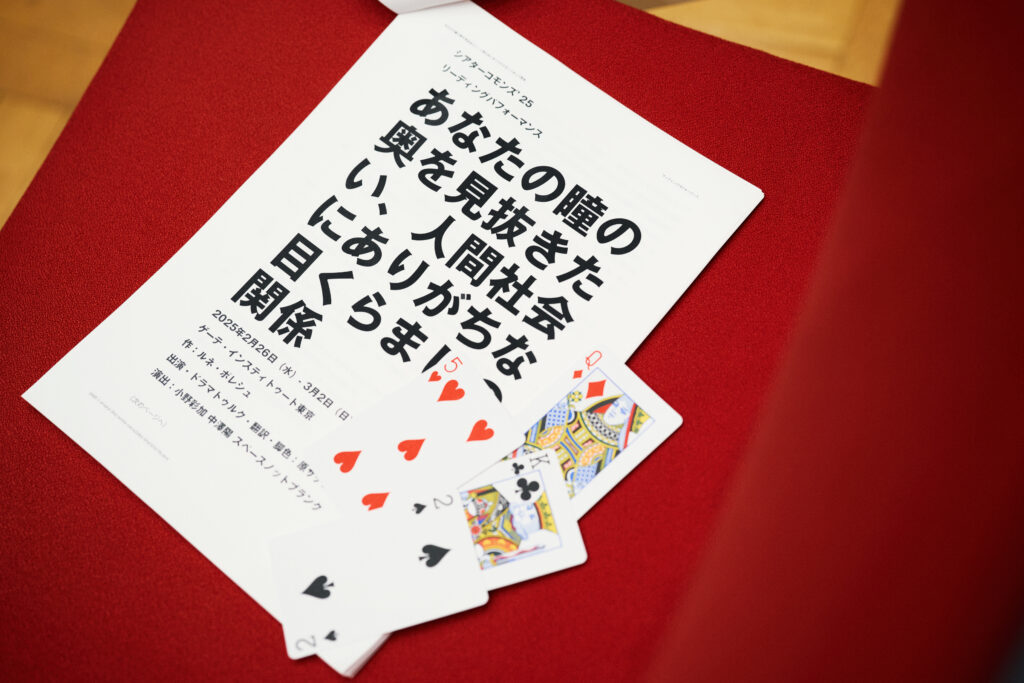
At the end of the first
Thinking off stage. Even now, I continue to write while thinking about what to think about. It all started when we proposed to Dance Base Yokohama (hereinafter referred to as “DaBY”) that we would like to write a “report” after the “Dance Work No. 1” residency was over. When we started writing it, we felt that we wanted to reflect comprehensively on what we were thinking now for ourselves rather than writing a one-time “report,” and we proposed it again as a “series” in the hope that it might be of use to someone else. DaBY was willing to accept our proposal. We are doing this “series” without being asked by anyone. We do not know who is reading it. But we want to make sure that this “series” will remain as something that can be read somewhere after we are gone.
This series of articles began with “Part 4” as a break. The reason why we did not call “Part 4” the “final installment” is that we may be able to consider “Part 5” and beyond again someday. If you know of a new “place” that would be willing to collaborate with us on this series, please send an e-mail to spacenotblank@gmail.com. We would be very happy if we could continue to collaborate with some other “places” after the “5th issue” and expand the series as a series that can be read while wandering across the vast ocean of the Internet.
To those of you who have read this series of articles about us. We run all of our social media on @spacenotblank. We hope you will follow us. Also, your words are an encouragement to our activities, so please post your thoughts and comments with #Thinking Offstage. And we sincerely hope to see you on stage again.
See you again.
Thursday, March 27, 2025
Ayaka Ono Akira Nakazawa Nakazawa Spacenotblank
Ayaka Ono Akira Nakazawa Nakazawa Spacenotblank Ayaka Ono Akira Nakazawa Spacenotblank
A collective of two stage artists, Ayaka Ono and Yo Nakazawa, who create performing arts productions. The company was founded in 2012 as a collective to create performing arts works. By integrating the established concepts of the performing arts with new mechanisms of their own research and development, they continue to explore the state of the performing arts in the modern age and attempt to create diverse values. As a resident artist at Dance Base Yokohama since 2023, he has been working on the project “Inherit the Body” as well as the “Inherit the Body” as a resident artist at Dance Base Yokohama since 2023. He has been involved in the residency program “Inheriting Bodies,” the showing of “Choreographic Concept 001 for Untrained Amateurs: Study on Weight and Movement (original work by contact Gonzo),” and the residency program and performance of the first part of “Dance Work No. 1: Claude Debussy’s ‘Practice'” at Dance Base Yokohama. The first part of “Dance Work No. 1: Claude Debussy’s Practice” was performed at Dance Base Yokohama. Wings”: International Dance Project by Dance Base Yokohama for Emerging Creators, a new work “Dance Work No. 3” will be created at Kinosaki International Art Center and Dance Base Yokohama from May 2025. It is scheduled to be premiered in October at Aichi Prefectural Art Theater, Small Hall.
▶︎ Dance Work No.3| Ayaka Ono Akira Nakazawa Nakazawa Spacenotblank


